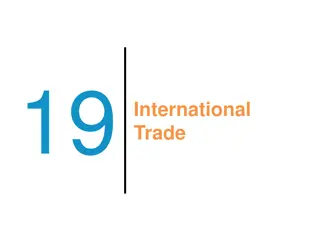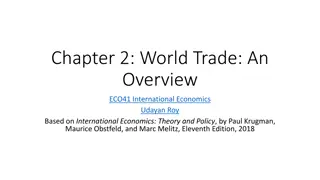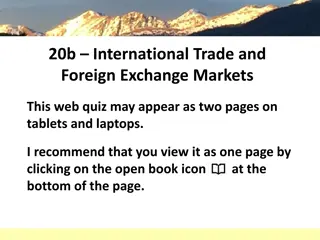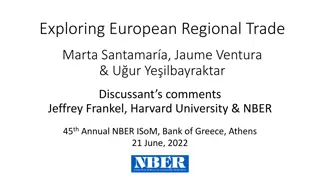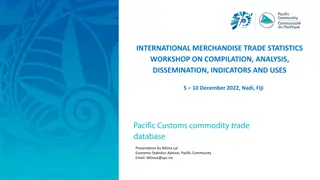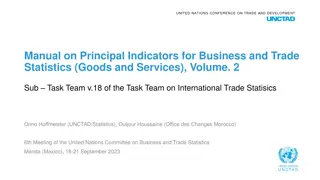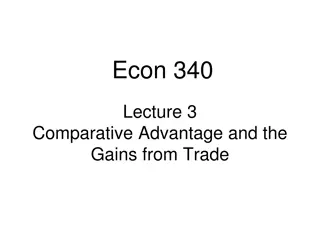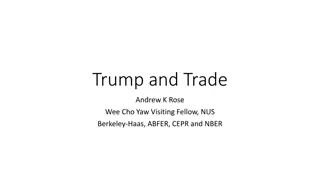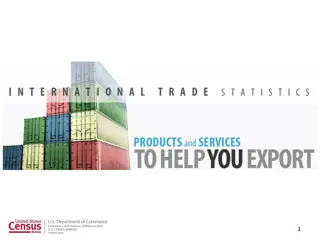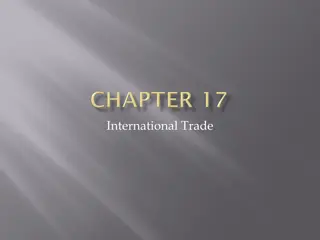Understanding Protectionism in International Trade
Protectionism in international trade refers to government policies aimed at restricting imports to support domestic industries, economic activity, safety, or quality concerns. It involves measures like tariffs, import quotas, and subsidies, which can have varying impacts on the local economy and global competitiveness. The debate over protectionism centers on its effects on economic growth, job creation, and consumer prices. Import tariffs and quotas are common protectionist tools used to regulate trade flow and protect domestic markets.
Download Presentation

Please find below an Image/Link to download the presentation.
The content on the website is provided AS IS for your information and personal use only. It may not be sold, licensed, or shared on other websites without obtaining consent from the author. Download presentation by click this link. If you encounter any issues during the download, it is possible that the publisher has removed the file from their server.
E N D
Presentation Transcript
WHAT IS PROTECTIONISM? PROTECTIONISM INTERNATIONAL TRADE TO HELP DOMESTIC INDUSTRIES. PROTECTIONIST POLICIES ARE USUALLY IMPLEMENTED WITH THE GOAL TO IMPROVE ECONOMIC ACTIVITY WITHIN A DOMESTIC ECONOMY BUT CAN ALSO BE IMPLEMENTED FOR SAFETY OR QUALITY CONCERNS. REFERS TO GOVERNMENT POLICIES THAT RESTRICT
UNDERSTANDING PROTECTIONISM UNDERSTANDING PROTECTIONISM Protectionist policies are typically focused on imports but may also involve other aspects of international trade such as product standards and government subsidies. The merits of protectionism are the subject of fierce debate. Critics argue that over the long term, protectionism often hurts the people and entities it is intended to protect by slowing economic growth and increasing price inflation, making free trade a better alternative. Proponents of protectionism argue that the policies can help to create domestic jobs, increase gross domestic product (GDP), and make a domestic economy more competitive globally.
Protectionist policies place specific restrictions on international trade for the benefit of a domestic economy. Protectionist policies typically seek to improve economic activity but may also be the result of safety or quality concerns. The value of protectionism is a subject of debate among economists and policymakers. Tariffs, import quotas, product standards, and subsidies are some of the primary policy tools a government can use in enacting protectionist policies.
TYPES OF PROTECTIONIST TYPES OF PROTECTIONIST Tariffs Import tariffs are one of the top tools a government uses when seeking to enact protectionist policies. There are three main import tariff concepts that can be theorized for protective measures. In general, all forms of import tariffs are charged to the importing country and documented at government customs. Import tariffs raise the price of imports for a country. Scientific tariffs are import tariffs imposed on an item-by-item basis, raising the price of goods for the importer and passing on higher prices to the end buyer. Peril point import tariffs are focused on a specific industry. These tariffs involve the calculation of the levels at which point tariff decreases or increases would cause significant harm to an industry overall, potentially leading to the jeopardy of closure due to an inability to compete. Retaliatory tariffs are tariffs enacted primarily as a response to excessive duties being charged by trading partners.
IMPORT QUOTAS Import quotas are non tariff barriers that are put in place to limit the number of products that can be imported over a set period of time. The purpose of quotas is to limit the supply of specified products provided by an exporter to an importer. This is typically a less drastic action that has a marginal effect on prices and leads to higher demand for domestic businesses to cover the shortfall. Quotas may also be put in place to prevent dumping, which occurs when foreign producers export products at prices lower than production costs. An embargo, in which the importation of designated products is completely prohibited, is the most severe type of quota.
PRODUCT STANDARDS Product safety and low-quality products or materials are typically top concerns when enacting product standards. Product standard protectionism can be a barrier that limits imports based on a country s internal controls. Some countries may have lower regulatory standards in the areas of food preparation, intellectual property enforcement, or materials production. This can lead to a product standard requirement or a blockage of certain imports due to regulatory enforcement. Overall, restricting imports through the implementation of product standards can often lead to a higher volume of production domestically.
GOVERNMENT SUBSIDIES Government subsidies can come in various forms. Generally, they may be direct or indirect. Direct subsidies provide businesses with cash payments. Indirect subsidies come in the form of special savings such as interest-free loans and tax breaks. When exploring subsidies, government officials may choose to provide direct or indirect subsidies in the areas of production, employment, tax, property, and more. When seeking to boost a country s balance of trade, a country might also choose to offer subsidies to businesses for exports. Export subsidies provide an incentive for domestic businesses to expand globally by increasing their exports internationally.
WHAT ARE EXAMPLES OF PROTECTIONISM? Common examples of protectionism, or tools that are used to implement a policy of protectionism include tariffs, quotas, and subsidies. All of these tools are meant to promote domestic companies by making foreign goods more expensive or scarce.








